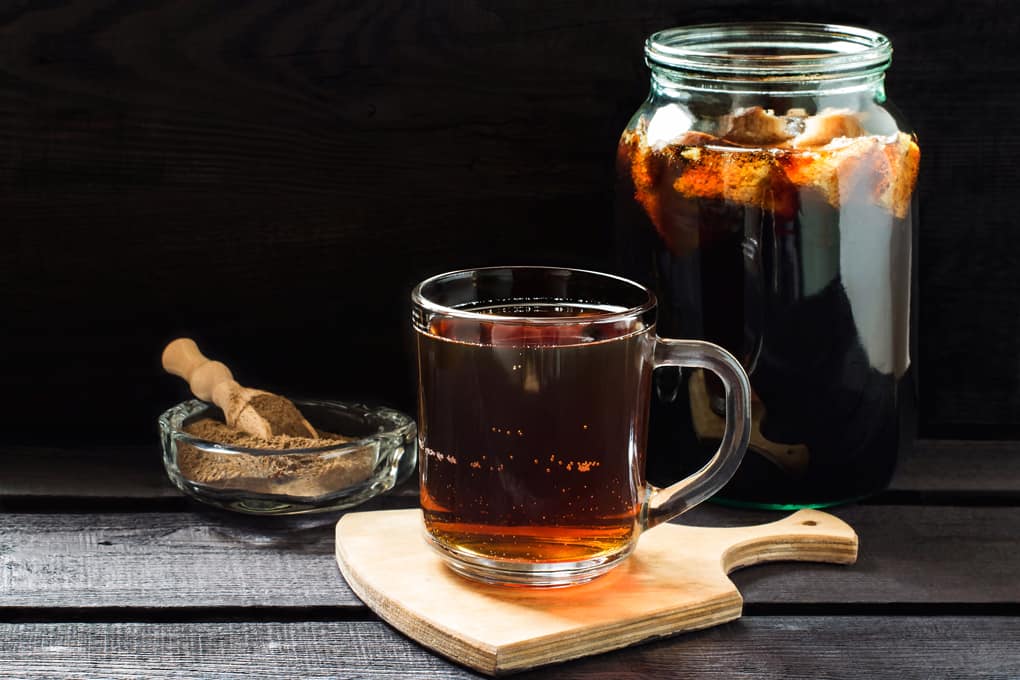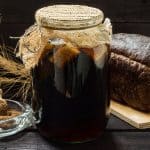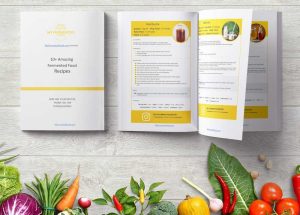![How to Make Kvass [Bread Kvass Recipe]](https://myfermentedfoods.com/wp-content/uploads/2018/10/Resized_Depositphotos_103328954_ds.jpg)
If you have heard of Kvass or have tasted it already, you must be eager to find out what goes into making it. The unique taste of Kvass must be lingering on your taste buds. If you want to enjoy the delicious flavors of this lacto-fermented beverage, here’s all that you need to know to prepare it at home.
What is kvass
Kvass is a refreshing and effervescent lacto-fermented beverage usually made from old bread. It is full of probiotics and is easy and affordable to brew it.
Kvass is common drink in many Eastern European countries with origins in Russia, Ukraine and Lithuania. It is considered a non-alcoholic drink as the alcohol content from the fermentation is only 0.5%-1%.
To make kvass you will need sourdough starter or you can use a packet of yeast to start kvass instead. Traditionally kvass is made from rye bread, but bread from wheat or other grains can also be used. The bread should be stale but fresh bread is fine too.
What does kvass taste like
Kvass is slightly sweetish in taste with a tinge of bitterness. However, depending on how you prepare it, you can reduce or increase the sweet and bitter taste to suit your preferences.
You can let the sweet taste dominate while masking the bitterness. Alternatively, you can enjoy the mix of the sweet-bitter taste of classic Kvass.
You will also feel the traces of the taste of yeast or black bread, usually in small amounts. It bites your tongue and creates that sense of tingling. This is due to the process of carbonation and the small amount of alcohol present in it.

Kvass benefits
Nutrition Facts
Kvass offers a nutritionally rich beverage that can support your body’s functions by providing numerous vitamins and minerals. Kvass is one of the best natural sources of vitamin B12, manganese, iron, copper, selenium, niacin, and magnesium.
It contains just 70 to 80 calories per 10-ounce serving, which makes it a great beverage to satisfy your thirst and cravings without overloading yourself with calories. It also provides a moderate amount of dietary fibers.
Probiotics
Just like most other fermented beverages, kvass too contains healthy bacteria that can enhance the functions of the gastrointestinal tract and relieve the symptoms of lactose intolerance and other digestive problems. Regular intake of kvass can provide relief from flatulence, constipation, bloating and may even lower the risk of rectal cancer.
Liver Cleanser
Kvass made from beet juice may enhance the liver functions and detoxify this vital organ. It can protect the liver against free radical damage by acting as an antioxidant. The iron and potassium content of Kvass helps to reduce inflammation and damage in the liver and reduce the risk of chronic hepatic diseases.
Anti-Cancer Potential
Kvass possesses anticancer potential thanks to its ability to eliminate toxins from the body. It may be able to protect the healthy tissues and organs against cancer-causing agents by supporting detoxification processes.
Kvass made of beet may help to prevent tumor formation in various organs and inhibit the growth of breast, pancreatic, and prostate cancers. Kvass also has antioxidant properties that may prevent cancerous changes in the skin, lungs, and liver.
Blood Tonic
Regular intake of kvass is recommended to promote the elimination of toxins from the blood. It can cleanse the circulatory system and ensure all the organs and tissues receive healthy nutrients. These benefits of Kvass can help to improve skin health and make it appear vibrant and glowing.
How to make kvass
Making Kvass at home is easy. The ingredients required are simple and the process is easy to understand. If you are eager to make Kvass at home and surprise your family with its delicious flavors, read on to find the best and easiest bread Kvass recipe:

Bread Kvass Recipe
- Total Time: 30 minutes
Description
Kvass is a refreshing and effervescent lacto-fermented beverage usually made from old bread
Ingredients
- 450 gr stale or fresh rye bread
- 9 litres water
- Handful of raisins
- 4 cups sugar
- 250 gr sourdough starter
Instructions
- Fill the stockpot with 9 litres of water and bring to boil.
- Toast bread in a toaster on the darkest setting twice or directly on the racks in a preheated oven on 200°C. The darker the bread is toasted, the more flavourful the kvass will be.
- Cut bread in thin slices. Remove water from the heat and add the handful of raisins and toasted sliced bread. Cover it with the lid and leave it to soak for next 8 hours or overnight.
- Remove the toasted bread and discard it. Keep the raisins in the stockpot.
- Add sugar and sourdough started to the stockpot. Cover it with the lid. Leave kvass to ferment for another 8 hours and stir it as often as possible (ideally every 2 hours).
- Kvass should be bubbling which means it is ready to be bottled.
- Discard floating raisins by scooping them up with a large spoon.
- Gently pour kvass into plastic bottles using strainer or cheesecloth to remove any particles. Add two raisins in each bottle then close the lids.
- Leave the ferment in a cool place. In the next 24 hours raisins will rise to the top as kvass carbonates.
- Once kvass is carbonated take out the raisins and transfer bottles into refrigerator to slow continued carbonation.
- Serve bread kvass as cold beverage.
Notes
Equipment: 3 large glass or plastic bottles, large stockpot, chopping board, knife, strainer or cheesecloth and a spoon.
- Prep Time: 30 minutes
- Cuisine: Eastern European
Nutrition
- Serving Size: 10 ounce
- Calories: 76
- Sodium: 114 mg
- Fat: 0.6 grams
- Carbohydrates: 16 grams
- Fiber: 1.1 grams
- Protein: 1.6 grams
Where to buy kvass
If you prefer to buy Kvass instead of making it at home, there are a few brands available for purchase online.
Kvass Ochakovskiy
Kvass Ochakovskiy offers a simultaneous alcoholic and lactic fermented kvass. It is loaded with numerous benefits, thanks to the carefully-crafted and well-monitored process of fermentation.
It also contains a unique set of nutrients and amino acids needed to improve the body’s functioning.
The double fermentation of this dark Kvass imparts a sweetish sour taste emanating with the tempting aroma of crispy rye bread. Made of natural ingredients; this Kvass is perfectly refreshing for your mind and body. It can rehydrate your skin, relieve thirst, and give strength.
Imported Russian Bread Drink Kvasochakovsky
If you prefer Kvass made of Russian Bread, you can try this imported Kvasochakovsky to satisfy your cravings. It makes up for a refreshing drink you can rely on to reinvigorate your senses and feel fresh and energetic.
It tastes better when chilled. You can drink it at any time to improve your energy levels and overcome fatigue.
Fermented Beet Kvass Juice
Fermented Beet Kvass Juice may help with controlling diabetes, enhancing mental clarity, and supporting healthy digestion. The rich medicinal properties of Beet Juice in your Kvass can take its healthy quotient a notch higher. It is also organic, gluten-free, and vegan.
Alcohol content
Usually, kvass has less than 1% alcohol content. The alcohol content varies depending on how long it has been left to ferment. The longer it sits in your fridge, the more “alcoholic” it can get. However, it is still considered a non-alcoholic beverage because of the negligible amount of alcohol in it.
Kvass vs kombucha
To start with, kvass originated from Eastern Europe and Russia where the masses have been drinking it for thousands of years as an effective way to hydrate the body. The history and tradition of Kombucha, on the other hand, began in the Monasteries in the Far East where it was consumed as a source of energy and power.
The ingredients used to prepare kvass include bread, fruits, and vegetables while the basic ingredient of kombucha is sweetened black tea.
There are several other differences between Kombucha and Kvass that set them apart. The difference lies in the use of starters, brewing methods, and their tastes.
Conclusion
There are various other ways to prepare Kvass. Once you get your basics right, you can try different versions of using the flavors of your choice. You can choose the ingredients based on how you would like the final taste to be like. This way, you would be able to surprise your family with a new dish with amazing flavors quite often.




I thank you for posting this recipe. I like kvass very much but it’s not easy find around here. Since I enjoy fermenting, this recipe is gold to me. Thank you.
Thanks Rosa. Glad you like it 🙂
Very interesting, thank you. I am concerned, as a diabetic with the amount of sugar used ~ is it possible to use a powdered sugar substitute or will this not help fermentation ?
The powdered sugar substitute is unlikely to be suitable for fermentation. However, the fermentation process converts sugar into alcohol (less than 1% in this case) so you might still be able to drink kvass. You should consult your doctor first before consuming kvass.
Thank you for your help it is appreciated.
I read you can keep the filtered out portion in the cheese cloth as a starter for your next batch.
Any idea of how to store that?
Hi Tatiena, I’m not aware you can do that.
Hi Gigi. Can I substitute the sourdough starter with yeast? And if so, how much yeast should I use for the recipe? Thanks
Hi Nina, Yes you can use yeast instead. I would suggest 1 1/2 tablespoons of a dry active yeast. Enjoy!
Thanks Gigi!
Hi Gigi! How long can you store the kvass?
Hi Angelika, I would recommend storing kvass for 7 to 10 days.
Hi from Selah , Washington. I have been making rye bread kvass using you recipe and it is fantasticodelicious !! I have done a certain amount of research and your recipe and method are laid out in such a simple and efficient way which I greatly appreciate. Thank you. Kvass is now my favorite home made drink. I don’t drink alcoholic beverages but I enjoy this blend of flavors which is mildly sweet and still grown up richness. I will be experimenting with flavor variations soon. I’ll let you know. I am also a fermentation nerd and I am fortunate enough to have my own fermatory kitchen. Once again thank you.
Thanks David for your kind words! I’m glad to hear you’re enjoying homemade kvass. Once you start experimenting with other flavors please share your experience. We would love to hear.
Thanks for this recipe. Have you had any success with substituting the sugar with raw honey?
Hi Christine, I haven’t tried to substitute sugar with raw honey. However, I can’t see why it wouldn’t work. As a general rule, for every cup of sugar substitute 1/2 to 2/3 of a cup of honey.
Many thanks for that quick reply and the tip!
Thanks for such a great recipe using sourdough starter. I’m waiting for mine to ferment, but I can already smell it’s going to be delicious! I’ve used dry yeast in the past and wasn’t super happy with the result
Thanks for the lovely words Krystian. Enjoy! 🙂
Hi Gigi! Where can I find sourdough starter?
Hi Marina, you can make a sourdough starter at home. It’s simple and easy: https://myfermentedfoods.com/how-make-sourdough-starter/.